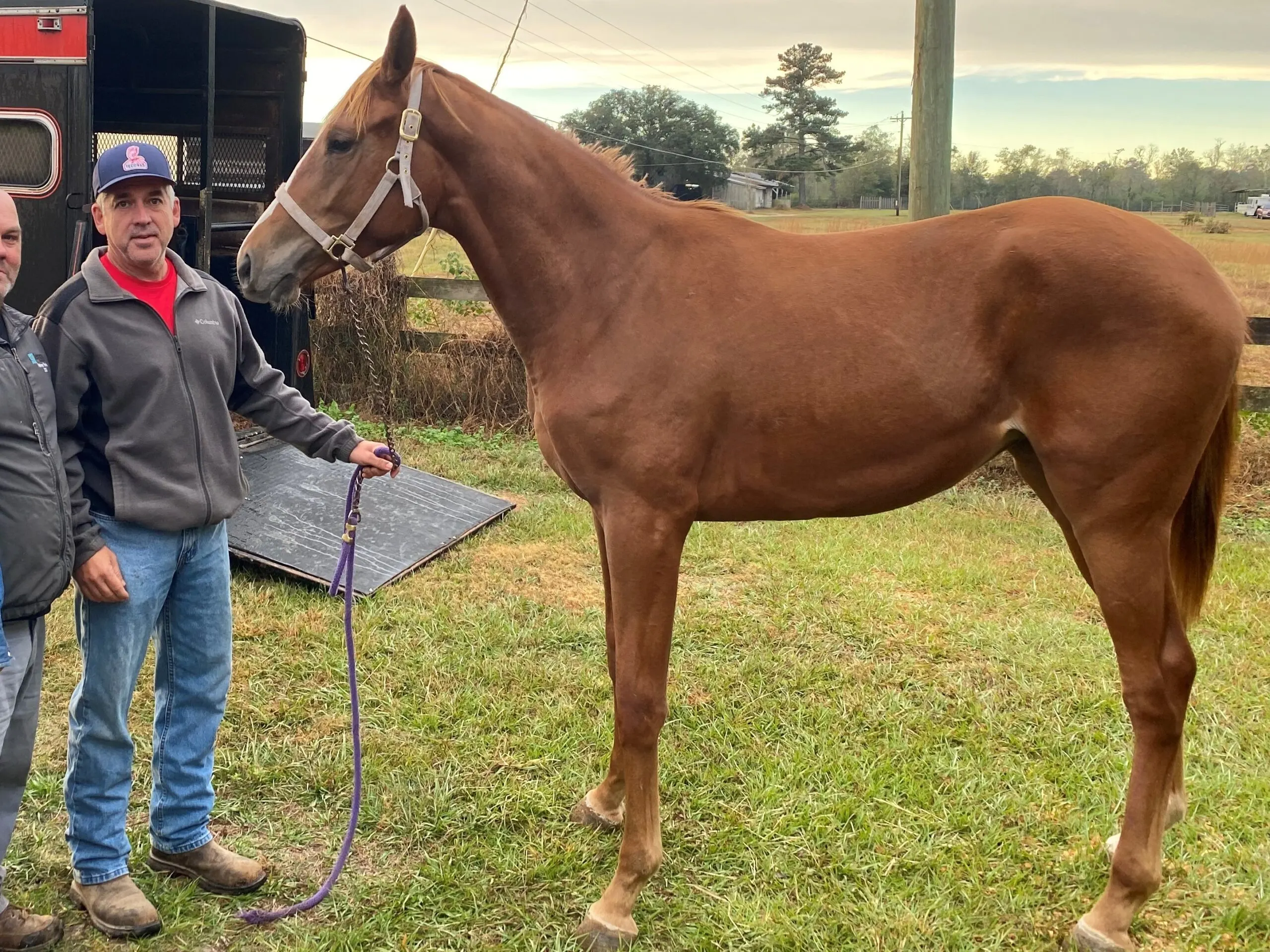Last updated: March 19, 2024
In the high-stakes world of horse racing, the nuanced use of tongue ties plays a pivotal role in enhancing a racehorse’s performance. As a seasoned racehorse owner, I’ve seen how these tools, aimed at preventing the horse’s tongue from slipping over the bit and ensuring unimpeded breathing, are indispensable for control and safety on the track.

Why Tongue Ties Are Used
Tongue ties serve two main functions: enhancing control and ensuring optimal breathing. Here’s how they address these critical aspects:
Enhancing Control and Safety
Tongue ties secure the tongue and prevent it from interfering with the bit, ensuring clear communication and effective control between the horse and rider. This is crucial for maintaining focus and safety during high-speed races.
Addressing Breathing Challenges:
One significant breathing challenge racehorses face is Dorsal Displacement of the Soft Palate (DDSP). This condition occurs when the soft part at the back of the horse’s mouth moves out of place, potentially blocking the airway.
It’s akin to the discomfort humans feel when something “goes down the wrong pipe,” leading to coughing. For horses, DDSP can severely affect their ability to breathe deeply and perform at their best during a race.
How Tongue Ties Help with DDSP
Tongue ties are designed to keep the horse’s airway open by preventing the soft palate from displacing. By holding the tongue in place, they ensure that the airway remains unobstructed, allowing the horse to breathe freely and maintain stamina throughout the race.
Types and Application:
- Traditional cloth bandages and modern synthetic ties with Velcro closures cater to different preferences, emphasizing the importance of a careful, informed application process. This involves dampening the material, gently securing the tongue, and ensuring the tie is snug yet comfortable.
Right and Wrong Application
Correct Application
A properly applied tongue tie should allow the horse’s tongue to remain in its normal position, ensuring comfort and effectiveness without interfering with swallowing or causing undue stress.

Common Mistakes
- Excessive Tightness: Tying the tongue too tightly can restrict blood flow and cause discomfort.
- Improper Positioning: A tongue tie that pulls the tongue out to the side can interfere with other functions and indicate incorrect application.
Below is a YouTube video showing how to tie a horse’s tongue.
Expert Insights and Scientific Perspectives
Kevin Thomas, a long-time trainer, underscores the ability of seasoned professionals to recognize when a tongue tie is necessary. This practical knowledge, combined with scientific research, such as the studies highlighted in the Equine Veterinary Journal and work by Dr. Heather J. Chalmers, points to the selective effectiveness of tongue ties. These studies reveal that while tongue ties can significantly aid horses with DDSP, their application should be tailored to individual needs, underscoring the ongoing evolution of equine care practices.
Additional insights from the School of Veterinary Studies at The University of Edinburgh and the American Journal of Veterinary Research further support the potential benefits of tongue ties in improving breathing in horses with DDSP, though not necessarily for those without airway issues.

Ethical Considerations and Best Practices
While tongue ties are a valuable tool in horse racing, their use must be guided by ethical considerations and best practices to ensure the welfare of the horses. This includes proper application, monitoring for signs of stress, and exploring alternative solutions when necessary.
Alternatives to Tongue Tying in Racehorses
While tongue tying has been a traditional practice in horse racing, there are alternative methods and equipment that trainers and veterinarians are exploring to address similar issues of control and breathing without the need for tying the horse’s tongue. These alternatives are gaining attention as the industry continues to prioritize equine welfare and comfort.
Alternative Equipment
- Bit Adjustments: One of the simplest alternatives is adjusting the type or fit of the bit. Different bit designs can offer better control and comfort, reducing the horse’s urge to get its tongue over the bit.
- Figure-8 Nosebands: These are designed to keep the horse’s mouth closed and prevent it from getting its tongue over the bit, offering a less invasive solution compared to tongue ties. We currently use a figure 8 on one of our racehorses.
- Cornell Collar: Developed as a non-surgical alternative to treat DDSP, the Cornell Collar applies pressure to the horse’s larynx, holding it in a position that reduces the risk of soft palate displacement.
Training Techniques
- Behavioral Training: Some trainers focus on behavioral techniques to train horses not to get their tongue over the bit. This approach often involves patience and consistent training but can be a more humane method.
- Respiratory Training: For horses with breathing issues, specific respiratory exercises and training regimens are being explored to strengthen the respiratory system and reduce the incidence of DDSP.
Recent Innovations
- Endoscopic Analysis: The use of endoscopy to diagnose respiratory issues accurately has become more common. This allows for targeted treatment plans that address the root cause of breathing problems without resorting to tongue ties.
- Welfare-Focused Research: Ongoing research in equine veterinary science is leading to new insights and innovations. Studies are increasingly focusing on understanding the horse’s anatomy and behavior to develop equipment and practices that enhance performance while ensuring welfare.

FAQs
What Does It Mean When a Horse Flips Its Palate?
“Flipping the palate,” or dorsal displacement of the soft palate (DDSP), occurs when a horse’s soft palate moves above the epiglottis, obstructing airflow. This can happen during a race, causing the horse to slow down to swallow and reposition the palate.
Why Do Racehorse’s Tongues Hang Out?
A horse’s tongue might hang out due to nerve damage from consistent, tight tongue tying. This is often noticeable when the horse is relaxed and is not a proper method of tongue tying.
Can a Horse Swallow Its Tongue?
No, horses cannot swallow their tongues. This term usually refers to dorsal displacement of the soft palate (DDSP), where the soft palate obstructs airflow. While horses can move their tongues extensively, actual swallowing of the tongue is anatomically impossible.
Is Tying a Horse’s Tongue Cruel?
Tongue tying itself isn’t inherently cruel, but it can cause stress. Studies show it helps prevent DDSP and improves breathing. However, signs of stress, such as head tossing and increased saliva, have been observed, leading to ethical debates and restrictions in non-racing equine sports.

Conclusion
Tongue ties, when used correctly, are an essential component of racehorse gear, contributing to safety, performance, and animal welfare. By understanding their purpose, ensuring proper application, and adhering to ethical practices, trainers and jockeys can maximize the benefits of tongue ties while prioritizing the health and well-being of their equine athletes.
We hope this guide shed light on the important role tongue ties play in horse racing. But we know every horse and experience is unique. Have you noticed a difference in performance with the use of tongue ties?
Do you have questions about applying them correctly? Share your stories or questions below, or explore more topics on our website to become even more connected with the fascinating world of horse racing. Your insights enrich our community and help us all grow together.
Stay Connected and Informed:
- If you found this guide helpful, consider signing up for our newsletter for more insights and updates on horse racing.
- For personalized advice or specific inquiries, feel free to contact me directly. I’m here to help guide you through your racehorse journey.
Meet Miles Henry
An avid equestrian and seasoned racehorse owner, Miles Henry brings his extensive experience to the equine world, proudly associating with the AQHA, The Jockey Club, and various other equine organizations. Beyond the racetrack, Miles is an accomplished author, having published various books about horses, and is a recognized authority in the field, with his work cited in multiple publications.
🔗 Connect with Miles:
Twitter
Facebook
YouTube: Check out race highlights, horse care tips, and more!

